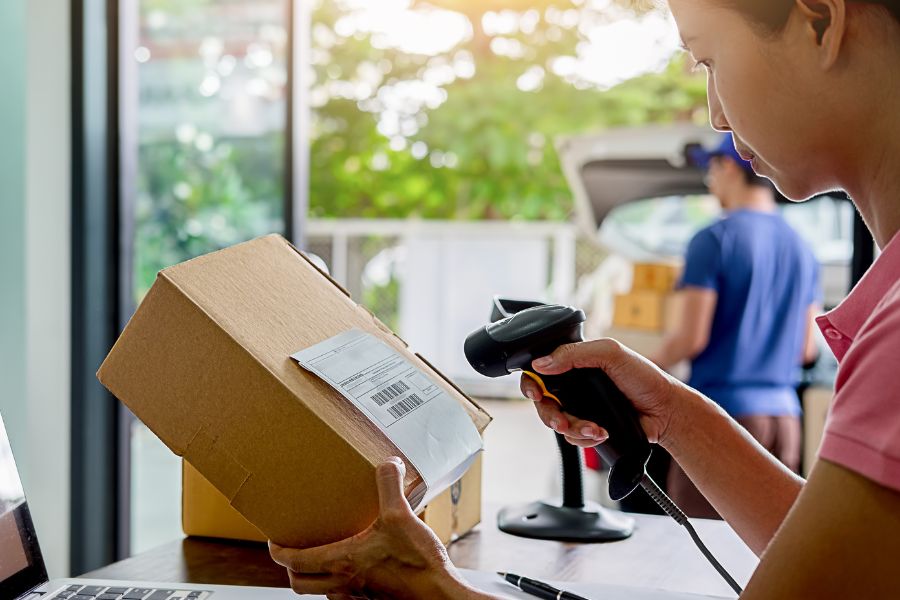Inventory control is the backbone of any product-based business, and barcode technology plays a central role in improving data accuracy and operational speed. For companies managing stock across locations or channels, inventory management software with barcode capabilities goes beyond simple tracking. It creates a unified system where every scan updates stock counts, tracks movement, and supports informed decision-making. This guide shows how barcode-enabled tools support inventory accuracy, cut manual errors, and simplify product management across warehouses and sales points.
Highlights:
- Different inventory models like JIT, MRP, EOQ, and DSI each serve specific business needs, and barcode-based tracking strengthens them all by improving accuracy and real-time visibility.
- Barcode inventory management software reduces manual errors, speeds up stock handling, and provides cleaner data for smarter decisions and timely reordering.
Types Of Inventory Management
Companies rely on various inventory management methods, which are tailored to their business model, industry, and supply chain complexity. The following approaches represent common models applied across retail and manufacturing, each with distinct workflows and risk considerations.
- Just-in-Time (JIT): Built on the production approach pioneered by Toyota, this model maintains low stock levels by aligning purchases closely with immediate manufacturing needs. Only the required materials are ordered per cycle, which cuts storage and handling costs. The system relies on precise timing; any disruption in supply or shift in demand can slow production due to limited buffer stock.
- Materials Requirement Planning (MRP): Materials Requirement Planning (MRP) uses sales forecasts to plan procurement of components. Past data guides material availability aligned with production goals. Effective coordination between sales, production, and suppliers is crucial. Forecasting errors or supply issues may cause delays or backlogs.
- Economic Order Quantity (EOQ): The EOQ formula determines the ideal reorder amount by considering both carrying and ordering costs. The method assumes stable demand and aims to balance inventory volume with order frequency. It avoids excess stock while reducing the frequency of replenishment. The model functions best under steady purchasing cycles and predictable consumption.
- Days Sales of Inventory (DSI): DSI calculates how long goods remain in stock before being sold. The metric includes both finished items and those in production. A lower value often indicates quicker movement, although results vary by industry. Businesses watch this figure to assess product turnover speed and the amount of capital tied up in inventory.
- Barcode-Based Inventory Management: Barcode-based function in inventory management software assigns unique codes to items, allowing quick tracking with scanners or mobile devices. This improves accuracy during receiving, picking, packing, and counting. When linked to inventory systems, it reduces manual errors and keeps stock data current. Barcode systems support real-time monitoring across JIT, MRP, and EOQ methods.
Benefits Of Barcode Inventory Management Software With Barcode
The barcode scanner market size is projected to increase by USD 4.92 billion at a compound annual growth rate (CAGR) of 9% between 2024 and 2029.

Also, according to a study by GS1 US, 90% of major global retailers already use barcodes for inventory management and point-of-sale (POS) systems. This highlights the widespread adoption of barcodes in inventory operations across the retail industry.
Barcode inventory systems remain a common tool for improving business efficiency and productivity. They reduce human errors, accelerate data entry, and streamline workflows, eliminating the need to count every item by hand.
5 benefits of inventory management software with barcode:
- Inventory tracking and recording gain accuracy. Manual tasks prone to errors like misreading numbers, skipping entries, incorrect data input, or illegible handwriting become less frequent.
- Barcode scanning offers greater precision, reliability, and speed compared to manual entry. When scanners read barcodes, the symbols are converted quickly and accurately into inventory software. Workers using barcode systems perform better than those relying only on manual entry.
- Barcode labels facilitate more efficient data collection processes. Labeling and scanning techniques are suitable for numerous applications across various industries, enhancing efficiency in multiple ways.
- Scanning systems help eliminate preventable errors. For example, in healthcare and pharmaceuticals, barcode inventory systems reduce medication mistakes when properly implemented.
- Data analysis improves with barcode systems. Higher-quality data delivers more accurate inventory details and real-time reports. Alerts notify when stock reaches set limits, so reordering aligns with production or sales needs.
Like other supply chain automation methods, barcode inventory systems enable businesses to complete more tasks more efficiently while reducing operational costs.
How to Implement a Barcode System for Inventory?
Once a decision has been made to adopt a barcode-based inventory tracking system, the next move is to begin setting it up in a way that suits the specific needs of your operation. To start, organize your inventory thoroughly. This process helps identify unique product characteristics and any system capabilities that would help accommodate them. Getting things in order at this stage will make the transition much more manageable and help clarify what the system should support.
The setup process consists of several parts, each contributing to the overall functionality of the inventory management software with barcode.
Choose And Integrate A Barcode Scanner
The barcode scanner must be compatible with both your product labels and inventory platform. Selecting the right one requires understanding your business’s scanning environment, whether it involves scanning in low light, dealing with damaged codes, or working in dusty warehouses. Beyond hardware selection, the connection between the scanner and your software needs careful configuration.
►►► Optimal solution set for businesses: Multi store POS, Next-gen POS, Inventory Management Software (MSI), Self Service, Automation, Backorders
Matching the scanner with your enterprise resource planning (ERP) or inventory management system is a technical process that requires input from both your IT team and operational managers, who know where it will be used most frequently.
Pick Your Inventory Tracking Software
Software selection should be based on how your business operates — product types, transaction volume, reporting needs, and future growth plans all play a role. Once you’ve narrowed down potential systems, test how well they work with your barcodes and scanners. Compatibility between all parts is a must. You want smooth data flow from the scanner into your software so that stock levels, sales, and reports reflect accurate, real-time information.
Identify The Most Suitable Barcode System
Before printing barcodes, assess what you’ll need to record about each product. Some businesses only need a simple identifier, while others may need to track location, expiration dates, or batch numbers. The format of the barcode, such as QR, Code 128, or UPC, should match these needs.
Inventory management software with barcode support works best when the barcode format suits your product data and scanning setup. Formats vary in capacity, print size, and scanner compatibility. Selecting the right one depends on what you need to record and where the scanning takes place.
Create and format your barcode labels
Designing your labels involves more than generating a code. Your product tags might include the barcode along with your branding, descriptions, or pricing details. This helps customers and staff quickly recognize the item while still allowing for fast scanning. You can print the labels in-house or work with a supplier. Consider label placement as part of this step — if everyone places barcodes in the same general area, it reduces the time spent searching during scanning.
Apply Labels To Physical Stock
Once the labels are printed, attach them to the actual products. Keeping placement consistent across similar items makes scanning faster and reduces the likelihood of error. Whether you’re labeling boxes in a storeroom or items in a showroom, placement should support easy visibility and access for the scanner.
Prepare Your Staff
The success of your inventory management software with barcode depends on your team knowing how to use it. Staff should be familiar with both the physical tools and the software interface. Manuals, video tutorials, and hands-on demonstrations are helpful in this process. Some vendors provide materials and live sessions tailored to different roles in your company, from warehouse workers to sales clerks. Don’t assume everyone will learn at the same speed; training should be scheduled in a way that supports long-term adoption and comfort with the system.
Test And Monitor The System
Before launching your new setup across the entire operation, try it in a limited area or with a specific product line. This test run allows you to identify errors or weak spots. After the rollout, review the performance periodically. Look for updates in both your software and hardware. Manufacturers frequently release updates that patch vulnerabilities, enhance the user experience, or add compatibility with new equipment.
It’s worth noting that changes to software often involve interface upgrades, bug corrections, and minor functional adjustments. Changes at the system level may include deeper modifications such as new security measures or major structural improvements.
Keep Your Data Current
Once the inventory management software with barcode is in regular use, build routines around it. Set a schedule for reviewing stock levels, checking labels, and backing up data. Some businesses find it helpful to do this on a weekly basis; others prefer monthly or quarterly cycles, depending on their sales volume and the frequency of stock changes. Use whatever tools your software provides to support this, whether it’s automatic reports, alerts, or inventory snapshots. Staying organized helps avoid overstocking, misplaced items, or late reorders.
ConnectPOS: A Powerful Barcode-Enabled Inventory Solution
ConnectPOS is a robust cloud-based inventory management software with barcode technology engineered to meet the complex demands of omnichannel businesses. For retailers that rely on accurate and real-time inventory management, especially those operating across multiple locations, ConnectPOS provides the necessary functionality to maintain control and visibility throughout the supply chain.
- Precision Through Barcode Scanning: ConnectPOS supports barcode scanning across various devices, helping maintain accurate data entry throughout the inventory process. This minimizes manual errors and supports consistent stock tracking across stores and warehouses. As products arrive or sales occur, updates appear instantly in the system, keeping stock levels aligned and operations clear.
- Centralized Inventory Management Across Locations:Retailers operating across various sites often face issues with stock inconsistency and scattered data. ConnectPOS consolidates all inventory information into a single dashboard, making it easier to track, assign, and transfer products between branches. Updates appear in real time, so warehouse teams and store staff work from the same figures, avoiding overselling and stockouts.
- Hardware Integration and Mobility: ConnectPOS supports a wide range of peripherals, including barcode scanners, receipt printers, and credit card readers. Its compatibility with iPads, Android devices, and desktop systems gives retailers the flexibility to operate both fixed-location checkouts and mobile POS setups. With support for Progressive Web Apps (PWA), businesses can even operate offline, ensuring continuity in areas with limited connectivity.
- Flexible Payment and Customer-Centric Operations: ConnectPOS supports split payments, gift cards, and layaway plans, helping businesses meet various customer needs. These options work in sync with backend systems for accurate updates in both sales and inventory. The platform also supports staff monitoring, role-specific access, and shift management, giving store managers oversight while allowing teams to run daily tasks independently.
- Smooth Omnichannel Integration: ConnectPOS integrates directly with major eCommerce platforms, including Magento POS, Shopify POS, WooCommerce POS, and BigCommerce. This makes it an ideal solution for businesses operating both physical and digital storefronts. Product, customer, and order data are kept in sync, ensuring customers receive a consistent experience across all channels.
Businesses can explore our inventory management software through a 14-day free trial, with no credit card required. After the trial, pricing starts at $39 per device/month, with custom packages available depending on business size and complexity.
FAQs: Inventory Management Software with Barcode
What is inventory management software with barcode?
It tracks product movement using barcodes. Each scan records stock activity, helping maintain accuracy and visibility throughout the process.
How does barcode scanning support stock accuracy?
It eliminates manual entry. As items are scanned during receiving, transfers, or checkout, the system logs the changes in real time.
Can it be used across different warehouse sites?
Yes. Businesses can manage stock in several locations through one platform, allowing oversight of quantity, location, and transfer status.
Which barcode formats are supported?
Common formats include UPC, EAN, QR codes, and Code 128. The system’s compatibility depends on your item types and industry.
Conclusion
Barcode-based inventory systems are a practical necessity for retail, wholesale, and supply chain operations that require reliable data and enhanced workflow control. Inventory management software with barcode integration supports precise tracking, faster fulfillment, and smoother cross-location coordination. For businesses looking to scale or improve internal processes, adopting a barcode-ready solution brings measurable improvements in visibility and accuracy.
ConnectPOS offers a barcode-enabled system designed for real-time updates, cross-device compatibility, and centralized management. Start your 14-day free trial, no credit card required, and see how ConnectPOS fits your business. Contact us now!
►►► Optimal solution set for businesses: Shopify POS, Magento POS, BigCommerce POS, WooCommerce POS, NetSuite POS, E-Commerce POS



